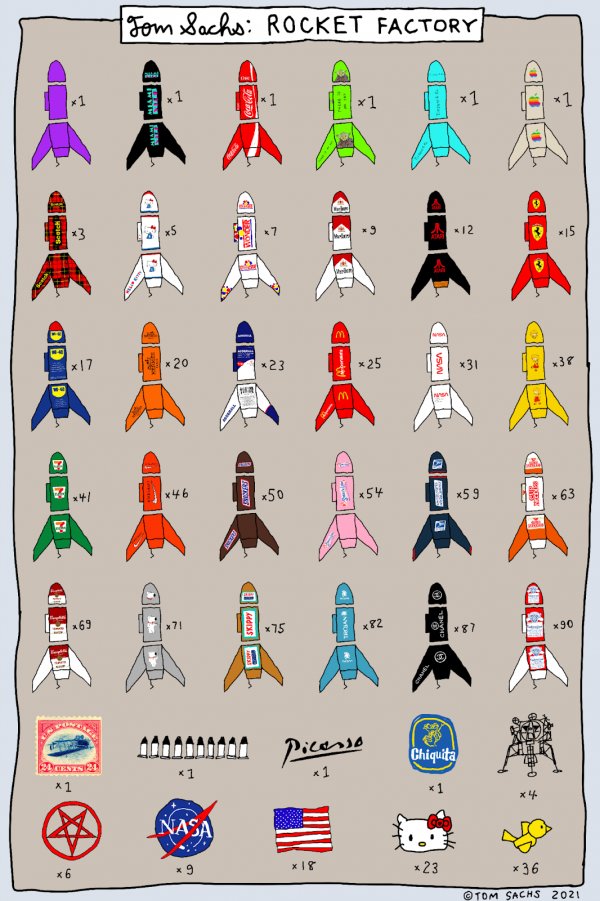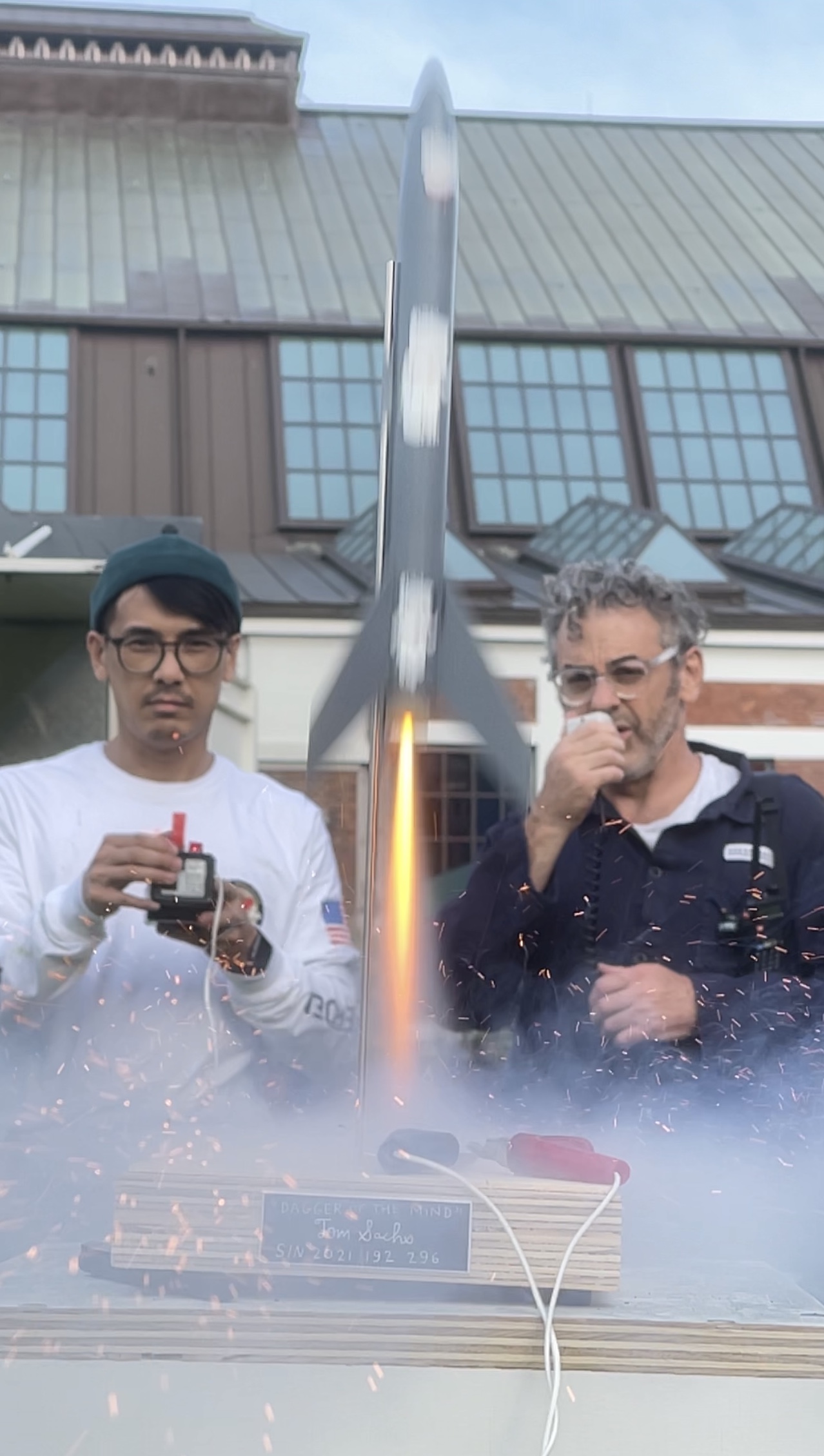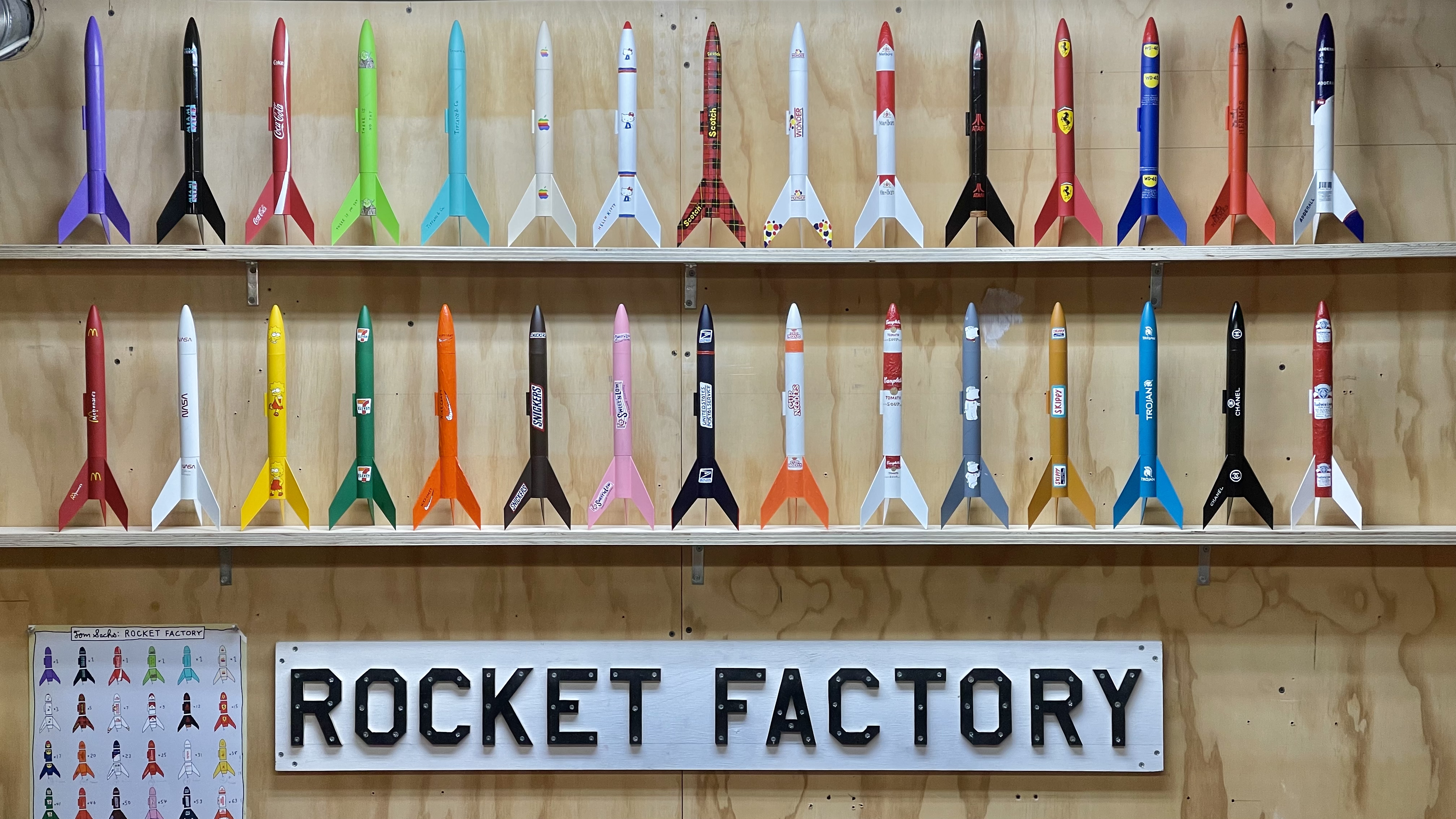For part 4 of NFTs and the Museum, we talk with Art + Technology Lab grant recipient Tom Sachs about his Rocket Factory, a custom-built digital platform that lives on the blockchain and serves as a marketplace where branded virtual Rocket Components are bought and sold as NFTs. The Rocket Factory allows participants to assemble three Rocket Components into either a Perfect Rocket or Frankenrocket: Perfect Rockets are composed of matching and singularly branded Components, and Frankenrockets are a discordant combination of different brands.
Once a Rocket is assembled, a Completed Rocket NFT is minted, and the Component NFTs are burned, an innovation Sachs calls “comburning.” Sachs’ Rocket Factory also provides an option to launch a Complete Rocket. Here, a physical twin of the Complete Rocket NFT is created. The sculpture is launched and recovered, the matching NFT is updated with a video link and metadata documenting the launch, and the Physical Rocket is then shipped to the owner in a vitrine, donated to the Rocket Factory’s Museum, or shredded. Combined, the Completed Rocket NFT, the video documentation, and the Physical Rocket replica form, in Sachs' words, “a Holy Trinity.”
Sachs has promised a Complete Rocket from his personal archive to LACMA, pending the museum’s implementation of an NFT policy. With the help of Art + Technology Lab advisor Anthony Sims, Principal Industrial Designer at SpaceX, and LACMA's own Corporate Partnerships team, the artist conceived an exquisite corpse: a Frankenrocket with a Cup Noodles-branded tail (chosen by Sims), a Chanel body (LACMA), and a Trojan nose cone (Sachs).
On Sunday, November 21, the artist and his Rocket Factory team will be at LACMA to launch the promised gift. After a brief ceremony and Q+A, LACMA’s Rocket will embark for the stars.
Joel Ferree: A lot of people know you as a sculptor, and someone who makes things with his hands. What brought you to NFTs?
Tom Sachs: Even though I am a plywood prosthelytizer, I use computers every day. The studio has been making movies for 20 years and that’s digital art, it only exists on the screen, but has the same values as anything we make in plywood. A real artist isn’t afraid to use technology. Technology is how I connect with a larger community, and expand on the values of my work and my studio. Half the job is making the sculpture, and the other half is communicating the ideas.
The blockchain is about transparency. In my sculpture you can see the pencil marks and the glue drips. The wood is painted and then cut. It is evidence of how the thing was made and who made it. What excites me about NFTs is that the rules, the boundaries, are transparent and concrete throughout the blockchain. No one person owns the information, and you can see the digital fingerprints of everyone that was there before you. That degree of transparency makes it democratic and decentralized. It allows for everyone to control it. It’s utopic.
Art is a place where we create our own realities, and successful created realities are based on trust and guidelines. Without guidelines and rules it’s all meaningless. In conceptual art, it’s the idea and its execution. Sol LeWitt’s Incomplete Open Cubes (1974) and CryptoPunks (2017) have a lot in common. Both establish basic guidelines which generate a defined set of outcomes. A person could never comprehend 10,000 unique CryptoPunks hanging on the wall of a gallery. Only a computer can filter and present the information in a way that we can understand it. Making the connection between those two works was the point when I decided to build the Rocket Factory.
Joel: A story was created during the development of our Frankenrocket. I was able to get Anthony Sims from SpaceX on the phone and said, “okay, we’re doing this project—which tail assembly do we use?” And he said, “I’d go for Cup Noodles because our engineers are working these late hours and it’s a staple.” There was that idea, almost a philosophy that was embedded in this tail assembly they selected. LACMA chose the Chanel body because that was something our development department, who deals with the brands at the museum, strongly felt we needed to do. With each selection you could feel this mythology developing around this Rocket we were assembling. When we asked you about the nose cone, you chose Trojan. Can you tell us your thought process behind your choice?
Tom: I’m interested in the comparison between Apollo and Dionysus as the two extremes in our world, my identity, and my work. The Trojan nose cone in a way represents the two sides: Responsibly irresponsible. But more to your point, the 30 brands we chose for the Rocket Factory are all deliberate. Brands form our sense of tribal belonging. In my childhood, at the kitchen table we would discuss dad’s new car or mom’s new dress. Brands are the foundation of the dominant religion of our era—consumerism. Our relationship to branding is a way we define ourselves. We picked our 30 Rocket brands because of some attachment I have or because I identify with them on some level. The story of LACMA’s Frankenrocket shows the power of one of the Rocket Factory’s most unique aspects. We allow people to create these stories themselves. We just provide the framework, but it’s up to you to decide what Rockets get made. There is the technical innovation of “comburning” that we introduced to make this happen, but equally important is giving people the ability to create something that resonates with them, that they care about. We put the power in their hands. The community decides, out of over 113,500 potential combinations, which 1,000 Rockets the world needs.
Joel: A lot of thought went into the Rocket Factory digital marketplace. Can you tell us about the steps you took? What you thought about while shaping the mechanics so that transparency and fairness were factored?
Tom: We see the potential for NFTs to reshape the way art is produced and distributed. The Rocket Factory, and all of the NFTs it generates, are artworks. These artworks draw on the foundation of sculpture and painting I have made for over thirty years. I see no difference between this project and a Tom Sachs sculpture at a museum.
First, we wanted the Marketplace to look like us, so that when you come into this world you see it as a gesamtkunstwerk. Whether it's the zipper pull on a backpack, a resin repair on a plywood boombox, or an online marketplace, these are all opportunities to express the values of the studio.
Joel: Thank you, Tom, for participating today. It's an honor to include you in this dialogue we’re having about NFTs. We’re grateful for all the support you’re lending LACMA in learning the nuances of this new world we’re coming into.
Tom: Thank you, Joel, and thank you to Erum Shah and Charlie Koss for being here, because, really, we three are the Rocket Factory. I know my name is on it, but it is our project. I’ve learned so much from them, and we’ve all been learning together. This is the first time since the American hardcore punk scene that I felt a connection with an art movement. This community has been bottomless in its generosity of sharing and teaching. My intention is to continue paying it forward. It’s really my honor to teach this because I believe in this space.
RSVP here for the Tom Sachs Rocket Factory Launch #6: Los Angeles on Sunday, November 21, at 3 pm.
The Art + Technology Lab is presented by
The Art + Technology Lab is made possible by Snap Inc. Additional support is provided by SpaceX and Google.
The Lab is part of The Hyundai Project: Art + Technology at LACMA, a joint initiative exploring the convergence of art and technology.
Seed funding for the development of the Art + Technology Lab was provided by the Los Angeles County Quality and Productivity Commission through the Productivity Investment Fund and LACMA Trustee David Bohnett.






